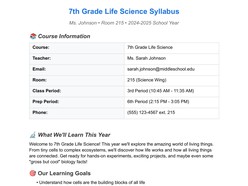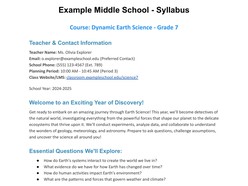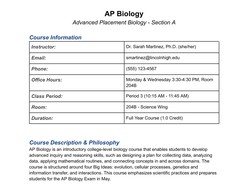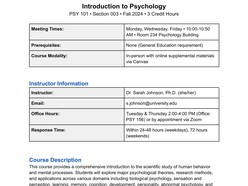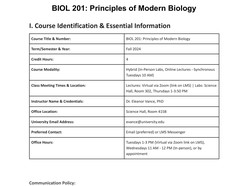Blueprint for Success: Crafting Effective Syllabi with Google Docs Templates
A course syllabus is the foundational document for any educational endeavor, serving as a roadmap, a contract, and a communication tool between instructor and students. Far more than a simple schedule, a well-crafted syllabus sets clear expectations, outlines learning objectives, and provides a framework for academic success. Developing this crucial document systematically ensures clarity, consistency, and a positive learning environment from day one. Our Google Docs syllabus templates for college, high school, and middle school are designed to help you achieve just that.
Why a Well-Structured Syllabus is Essential for Academic Success
A comprehensive and thoughtfully designed syllabus is indispensable for:
Setting Clear Expectations: Students understand course goals, grading policies, deadlines, and behavioral standards, reducing ambiguity and potential conflicts.
Facilitating Student Organization: It empowers students to plan their time, manage workloads, and prepare adequately for classes and assessments.
Articulating Learning Outcomes: Clearly defines what students are expected to know or be able to do by the end of the course, guiding their focus and effort.
Serving as a Reference Point: Acts as a go-to resource for students and instructors throughout the semester for policies, schedules, and contact information.
Establishing a Professional Tone: A well-organized syllabus reflects the instructor's preparedness and commitment to the course.
Supporting Accreditation and Institutional Requirements: Often, specific elements are required by educational institutions for quality assurance and consistency.
Key Elements of an Effective Syllabus (Adaptable for College, High School & Middle School)
While the depth and formality may vary by educational level, a robust syllabus generally includes:
Core Course Information:
Course Title & Number
Instructor Name & Contact Information (email, office location, phone)
Office Hours / Availability
Term/Semester & Year
Class Location & Meeting Times (if applicable)
Course Description & Purpose:
A brief overview of the course content, its relevance, and its place within the broader curriculum.
Prerequisites or co-requisites.
Learning Objectives/Outcomes:
Specific, measurable statements describing what students will be able to know, do, or value upon successful completion.
Required & Recommended Materials:
Textbooks (including ISBNs, edition), software, supplies, online resources.
Grading Policy & Assessment Breakdown:
Clear explanation of how grades are calculated (e.g., percentages for exams, homework, participation, projects).
Grading scale (e.g., A=90-100%).
Policies on late work, make-up exams.
Course Schedule/Calendar:
A chronological outline of topics, readings, assignments, exams, and due dates. This may be more detailed for college and high school, and perhaps more flexible or thematic for middle school.
Course Policies:
Attendance and participation expectations.
Academic Integrity/Honor Code (plagiarism, cheating).
Classroom conduct/etiquette (e.g., use of technology).
Communication policy (how to contact instructor, expected response time).
Support & Resources (Especially important for College & High School):
Information on academic support services (writing center, tutoring), disability services, library resources, counseling services.
Accessibility Statement (Often Required):
A statement regarding accommodations for students with disabilities.
Developing Your Syllabus: A Strategic Process
Start Early & Plan Thoroughly: Begin outlining your syllabus well before the course starts.
Be Student-Centered: Write in clear, accessible language. Consider what information students need most.
Align Assessments with Objectives: Ensure your assignments and exams accurately measure the stated learning outcomes.
Be Consistent & Fair: Apply policies uniformly.
Review & Update Regularly: Each term, review your syllabus for necessary updates to content, policies, or dates. Our templates make this easy.
Leveraging Google Docs for Your Syllabus Templates
Using Google Docs for your syllabus offers significant advantages for busy educators at all levels:
Accessibility & Collaboration: Access and edit your syllabus from any device. Easily share with co-teachers, department heads, or teaching assistants for collaborative development or review.
Dynamic Formatting & Customization: Utilize headings, tables, lists, and diverse fonts to create a professional and easy-to-read document. Our templates provide a pre-structured, yet fully customizable framework.
Version History: Track all changes, revert to previous versions if needed, and see who made specific edits—perfect for iterative design and record-keeping.
Easy Sharing & Distribution: Share a direct link with students (view-only or allowing comments), embed on a course website, or easily download as a PDF for printing or LMS upload.
Integration with Google Workspace: Seamlessly link to Google Calendar for due dates, Google Drive for shared readings, or Google Classroom.
Time-Saving Templates: Our pre-designed college, high school, and middle school syllabus templates ensure you include all essential components, saving you valuable preparation time.
Ultimately, a well-crafted syllabus is an investment in a successful and productive learning experience for both instructors and students. By systematically outlining your course, you create a clear path to achievement. Our Google Docs syllabus templates offer a structured, flexible, and efficient starting point to build this essential educational tool.
